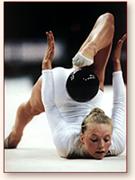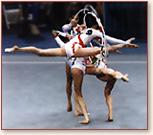
Rhythmic Gymnastics is one of the most beautiful of all sports with its competitors being renowned for their grace, athleticism and balletic qualities. This sport is a combination of dance, gymnastic movements and apparatus handling. There are five apparatus - the rope, hoop, ball, clubs and ribbon, but only 4 of these are used in competition at one time. Routines are performed to music and last between 60 - 90 seconds. The music should contain changes in mood and tempo, but only one piece can be used in each routine.
All routines must show fundamental body movements from the four catagories - Leaps and jumps, Balances, Pivots, and flexibility movements. Acrobatic elements, such as cartwheels and walkovers, used to be illegal but now they can also be included in routines as well. The gymnast is required to show amplitude, flexibility and skill but that is not enough. Performances must also be expressive and routines should be performed with confidence and poise.
Gymnasts wear leotards or unitards for competitions. A leotard is made of a stretchable fabric (like lycra) and comes in a wide variety of patterns, colours and textures. The Code of Points used to be very strict about what the gymnast could wear (no gold, silver or theatrical patterns) but the rules have now relaxed and gymnasts are experimenting with different colours and styles. Gold has since become a popular colour as it was previously forbidden. A leotard can be long-sleeved, short-sleeved or even sleeveless. Unitards, which look like leotards with leggings, have become popular in the last few years.

Another aspect of Rhythmic Gymnastics is the multiples competition. At the elite level, a group of 5 gymnasts perform 2 routines - one routine uses 5 similar apparatus, while the other routine involves 2 different apparatus. They perform the same elements as the individual gymnasts, but add in difficult exchanges and formations. At the grassroots of the sport, multiples competitions also include pairs and trios routines.

Home |
News & Events |
Information |
Multimedia
Glossary |
Training |
Guestbook |
Links
Disclaimer (please read)
|